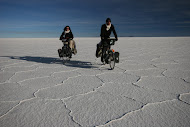In the region of Rio Ibáñez, Chile (Aysen region) and on the other side of the Andes in Argentina, were discovered cave paintings, which age has been estimated between 5000 and 10000 years. In caves, open or full, traces of hands have been painted in red!
On our way, near Cerro Castillo (Chile), we visited one of these sites declared national monument. A trail has been set up and lead to cave at the bottom of a high cliff that consisted of a thick lava flow (andesite flow). As the basis of an andesitic flow, made of scoriaes, is weaker and more porous than the main body of the flow, it is also more brittle and more easily eroded. Thus, the excavations are formed by differential erosion of the fragile basal part of the flow with respect to the erosion of the resistant body to the same flow.

It was a large mural painting that appeared under our astonished eyes. Large and smaller handprints were juxtaposed. These prints were colored in red and gave the impression that the color was projected thanks to an aerosol. In fact, the projection technique used by those men was similar but much more rustic: the Tehuelches indians used a tube filled with dye (mixed water and oxides of iron or copper) in which they blew. This is called an aerograph.




